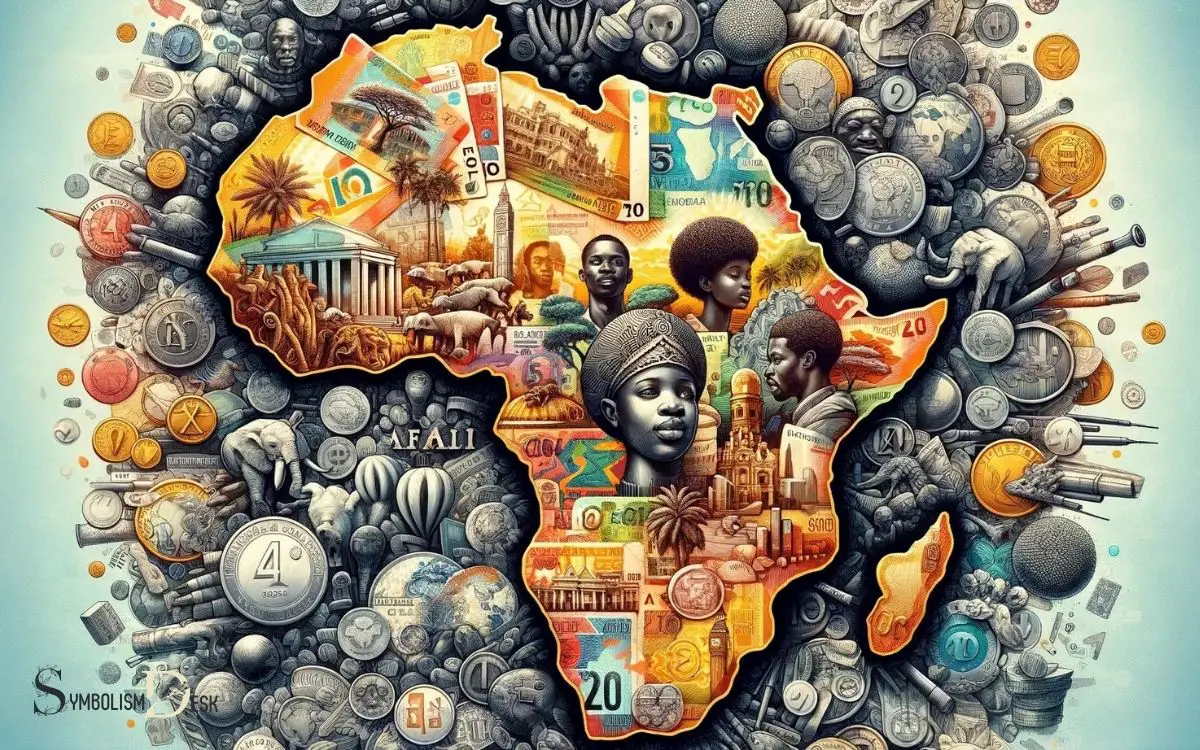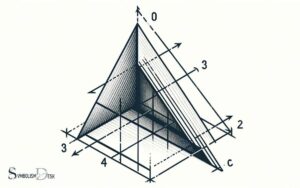Africa Currency Name and Symbol: Trade!
Africa’s monetary landscape is characterized by a diverse array of currencies, each with distinctive names and symbols.
The continent’s currencies range from the widely recognized South African Rand (ZAR), known for its economic significance, to the West African CFA Franc (XOF), which underscores regional monetary cooperation.
These currencies facilitate various economic activities, including business, trade, and travel, and are pivotal for economic transactions within the continent.
The currencies of Africa reflect its economic diversity, with each country or region adopting a currency that suits its financial system and economic policies.
For example:
Navigating Africa’s economic landscape requires familiarity with its varied currencies and symbols.

Key Takeaway
West African CFA Franc (XOF)
The West African CFA Franc (XOF) is utilized by several countries in West Africa as their official currency. These countries include Benin, Burkina Faso, Guinea-Bissau, Ivory Coast, Mali, Niger, Senegal, and Togo.
The currency is issued by the Central Bank of West African States (BCEAO). The XOF is pegged to the euro, with the exchange rate fixed at 1 euro to 655.957 XOF.
This fixed exchange rate provides stability for the currency and facilitates international trade and investment.
The West African CFA Franc is denoted by the symbol ‘CFA’ and is subdivided into smaller units called centimes. Its stability and widespread use make it an essential currency for the West African region.
South African Rand (ZAR)
The South African Rand (ZAR) is denoted by the symbol “R” and is known for its distinctive design featuring wildlife and historical figures. Its exchange rate is closely monitored due to its impact on international trade and investment within the region.
The Rand’s economic influence extends beyond South Africa, affecting the stability of neighboring countries and the broader African economy.
Rand Symbol and Design
Symbolizing the South African Rand (ZAR), the currency’s symbol and design hold significant cultural and historical meanings. The symbol for the Rand is denoted as “R” and is also often represented with the abbreviation “ZAR”.
The design of the South African Rand banknotes and coins features iconic figures, wildlife, and significant landmarks, reflecting the country’s diverse heritage and natural beauty.
The banknotes depict images such as Nelson Mandela, the Big Five animals, and the country’s unique landscapes. The coins showcase various elements, including the King Protea flower and the famous wildlife.
These symbols and designs not only represent South Africa’s rich history and culture but also contribute to the unique identity of the currency. Understanding the significance of these symbols provides insight into the nation’s values and heritage. These artistic elements serve as a reminder of South Africa’s journey and the diverse narratives that shape its identity. Similarly, exploring other nations’ currencies, such as the Afghanistan currency name and meaning, reveals a different set of cultural and historical influences that reflect the essence of their society. By comparing these symbols, one can appreciate the shared importance of currency as a cultural artifact around the world.
Rand’s Economic Impact
Having a significant impact on South Africa’s economy, the Rand (ZAR) influences trade, investment decisions, and economic policies.
As the official currency of South Africa, the Rand’s value has a direct effect on the country’s import and export industry.
Fluctuations in the Rand can impact the cost of imported goods and the revenue from exported products, thereby influencing the balance of trade.
Additionally, the Rand plays a crucial role in investment decisions both domestically and internationally. Its strength or weakness affects the attractiveness of South Africa as an investment destination.
Furthermore, the Reserve Bank of South Africa formulates its monetary policies, such as interest rates, with consideration to the Rand’s value and its impact on inflation and economic growth.
Therefore, the Rand’s economic impact is far-reaching and central to South Africa’s financial stability and growth.
Nigerian Naira (NGN)
Although the Nigerian Naira (NGN) has experienced fluctuations in value, it remains the official currency of Nigeria. The currency plays a crucial role in the country’s economic landscape and holds significance beyond its borders.
Here are key points to understand about the Nigerian Naira:
- Historical Context: The Nigerian Naira was introduced in 1973, replacing the pound as the country’s official currency.
- Fluctuations in Value: The Naira has faced challenges due to factors such as fluctuating oil prices, inflation, and economic instability.
- Currency Symbol: The symbol for the Nigerian Naira is “₦”, and it is represented by the code “NGN” in the foreign exchange market.
- Government Regulation: The Central Bank of Nigeria (CBN) regulates the issuance and circulation of the Naira, working to maintain stability and curb inflation.
Understanding these aspects provides insight into the significance and impact of the Nigerian Naira within Nigeria and the global economy.
Egyptian Pound (EGP)
The Egyptian Pound (EGP) is the official currency of Egypt and is denoted by the symbol “E£”. It has a rich history, having been in use since 1836, and has undergone various changes and developments over the years.
Currently, the exchange rate of the EGP fluctuates, impacting its value in international trade and finance.
EGP Symbol and History
The adoption of the symbol for the Egyptian Pound (EGP) took place in the mid-20th century and has remained a symbol of the currency ever since. The symbol for the Egyptian Pound is E£.
Here are some key points about the history and symbol of the EGP:
- Symbol Origin: The symbol E£ is derived from the first letter of the English word “pound” and is often used in conjunction with the numerical value, similar to other currency symbols such as $ for dollar or € for euro.
- Historical Continuity: The symbol E£ has been consistently used to represent the Egyptian Pound in financial markets, economic reports, and currency exchange platforms.
- International Recognition: The E£ symbol is widely recognized internationally and is used in global forex trading, making it an integral part of the currency’s identity.
- Symbol Usage: The symbol E£ is used in official documents, price tags, and banking transactions, providing a distinct representation of the Egyptian Pound.
The historical and continued usage of the E£ symbol underscores its significance in representing the Egyptian Pound.
Current EGP Value
The current value of the Egyptian Pound (EGP) in relation to major currencies reflects its stability in the global exchange market.
As of [insert current date], the exchange rates for EGP are as follows:
| Currency | EGP Exchange Rate |
|---|---|
| US Dollar (USD) | [insert value] EGP |
| Euro (EUR) | [insert value] EGP |
| British Pound (GBP) | [insert value] EGP |
The Egyptian Pound has demonstrated resilience against major currencies, providing a stable foundation for international trade and investment.
This stability is beneficial for both domestic and international stakeholders, fostering confidence in the Egyptian economy.
As Egypt continues to develop and strengthen its economic position, the stability of the EGP contributes to its attractiveness as a strategic market for global business endeavors.
Kenyan Shilling (KES)
Kenyan Shilling (KES) is the official currency of Kenya. It has been in use since 1966 when it replaced the East African Shilling.
Here are some key points about the Kenyan Shilling:
- Symbol: The symbol used to represent the Kenyan Shilling is “KSh”.
- Subunits: The Kenyan Shilling is divided into 100 smaller units known as cents.
- Coins and Banknotes: The currency is available in both coin and banknote form, with coins available in denominations of 50 cents and 1, 5, 10, and 20 shillings, and banknotes in denominations of 50, 100, 200, 500, and 1000 shillings.
- Exchange Rate: The exchange rate of the Kenyan Shilling fluctuates against other major currencies and is determined by the foreign exchange market.
The Kenyan Shilling plays a crucial role in the country’s economy and is widely used for both domestic and international transactions.
Ghanaian Cedi (GHS)
Since its introduction, the Ghanaian Cedi (GHS) has been a significant currency in the West African country of Ghana.
The currency has undergone several changes, including redenomination in 2007, where the old cedi (GHC) was replaced at a rate of 1:10,000, resulting in the current Ghanaian Cedi (GHS).
The Bank of Ghana regulates the currency, aiming to maintain its stability and value. The Ghanaian Cedi is represented by the symbol “₵” and is issued in banknotes and coins, with the banknotes featuring prominent Ghanaian leaders and cultural symbols.
The currency plays a crucial role in the country’s economy and is widely used for trade and financial transactions within Ghana.
Moroccan Dirham (MAD)
A stable and widely used currency in Morocco, the Moroccan Dirham (MAD) has played a pivotal role in the country’s financial system.
Here are some key points about the Moroccan Dirham:
- Fixed Exchange Rate: The Moroccan Dirham has a fixed exchange rate against the US dollar, which provides stability for international trade and investment.
- Controlled by Bank Al-Maghrib: The Moroccan Dirham is regulated and controlled by the central bank of Morocco, Bank Al-Maghrib, which helps in maintaining its stability.
- Coins and Banknotes: The Dirham is available in both coins and banknotes, with the banknotes featuring significant Moroccan historical figures and landmarks.
- Usage: The Moroccan Dirham is widely accepted for transactions within the country and is the only legal tender for all payments in Morocco.
The Moroccan Dirham’s stability and widespread acceptance make it an essential component of Morocco’s economy.
Conclusion
The currencies of Africa carry significant economic and cultural importance. Understanding the names and symbols of these currencies is essential for conducting business and trade in the region.
Despite potential concerns about currency stability, the diverse and dynamic African economy continues to present opportunities for growth and investment.
It is important for global stakeholders to stay informed about the currency landscape in Africa in order to capitalize on its potential.






